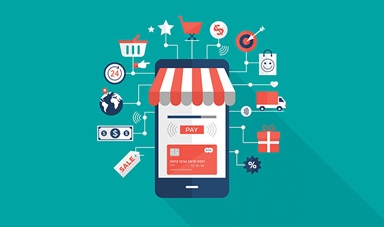At a glance
- New payment technologies have caused the payment landscape to evolve rapidly over the past decade.
- Businesses can reduce costs and receive payments faster with automated payments.
- Fintechs are focusing more on convenience in order to increase the speed at which businesses receive full payments.
How did you pay for your coffee today? Did you tap your credit card, wave your phone, beep your watch, or (yes, it’s a thing) swish your smart ring?
It’s unlikely that you reached into your pocket and pulled out a fistful of coins.
The written promissory note or cheque was a fundamental transformation in transferring value from customer to supplier.
Decades later, we are engulfed in a wave of payment vehicles and technology that would have been considered fantastical 50 years ago.
Payment methods are changing in business, too, led by a boom in fintech companies and government digitisation projects.
In Asia, most B2B payments are made on mobile platforms, often using QR codes. Long settlement periods are being replaced by instant transfers that shift funds between banks in near real-time.
The banks themselves are multiplying, with a wave of neobanks and tech companies being established – the Goldman Sachs-backed Apple Card one of the most prominent examples.
Faster, cheaper, better: modernisation and real-time processes
The banks, as the holders of capital, determine the cost of transactions.
Government regulators have been pushing banks to drop fees and move to instant payments, a trend that is sweeping through most OECD countries including Australia, the UK and the US.
Even SWIFT, the global framework for international payments, is looking at a real-time process.
A huge amount of innovation and capital investment is required to update the banks’ archaic and highly sensitive systems.
The banks also stand to lose their revenue from highly priced international transactions, but regulators are giving them little choice than to modernise.
Many fintechs are working on the real cause for blowouts, the administration of payments.
The best customers are recurring customers, and yet the ability to take recurring payments has been relatively difficult and often manual.
“It’s less about the transaction fees and more about the manual costs and the cost of the cash flow.
When your customer pays you 60 days late, that’s a real cost,” says Hiroki Takeuchi, CEO of GoCardless, a payments company that specialises in recurring payments.
Shifting to automated payments gives a business more control over cash flow and reduces the time spent chasing customers and reconciling transactions.
"It's less about the transaction fees and more about the manual costs and the cost of the cash flow. When your customer pays you 69 days late, that's a real cost."
GoCardless uses direct debit arrangements to minimise the transaction cost, and charges a percentage of the transaction (starting at 1 per cent) for automating the direct debit, invoicing and reconciliation processes.
Businesses in many sectors are moving to recurring payments, Takeuchi says.
Today we hail rides with Uber, Ola, Grab and other platforms rather than booking one-off trips with taxi companies.
Part of the convenience with ride-sharing platforms is in the payments; you just get out of the car at the end of the trip and the payment occurs in the background.
Uber also collects information about you on an ongoing basis. If you frequently travel for work, opening the app early in the morning will prompt it to ask if you’re going to the domestic airport terminal.
This data model potentially increases the value of the service supplied and the business that supplies it.
There is a lot of talk about the growing subscription economy, for everything from razor blades to car or boat ownership. Services including professional accounting for business can work especially well as monthly subscriptions rather than a once-a-year bill.
The important angle in both cases is the ongoing relationship with the customer. Companies moving into subscription-based business models are highly dependent on automatic payments to reduce costs.
“A lot of the time, the reason that these payments end up becoming late is not because the customers are unwilling to pay or can’t pay, it’s because they just don’t get around to it,” Takeuchi says.
An Australian alternative was launched in early October 2019 by FeeSynergy, a debtor management and fee finance provider that lends against an accounting firm’s accounts receivable.
It announced an “automated debtor management platform” with Westpac that handles online payments and recurring direct debits, and integrates with practice management systems such as Reckon APS and MYOB Accountants Enterprise.
Asking clients to pay their bills is a pet hate for accountants.
The average number of debtor days for the profession is between 65 to 90 days, according to research by FeeSynergy.
Taking payments: increasing adoption of online invoices

Every business wants to make sure they are paid in full as quickly as possible.
Ultimately, this relies on a customer’s willingness and ability to pay, both of which are subject to cash flow.
However, fintech companies claim that making it easier to make a payment can increase the speed of getting paid.
One of the biggest changes has been the increasing adoption of online invoices. A common approach is to send customers a PDF invoice by email.
Now, most cloud accounting software includes a link in the email that opens a web page with the invoice details and a “pay now” button.
The button activates an online payments engine, so the customer can pay the invoice immediately by credit card.
Xero claims that invoices sent online with a “pay now” button can get paid up to twice as fast as invoices without a payment option.
The downside is that the supplying business has to pay transaction fees to the payment processor such as Stripe, PayPal or Australia’s eWay.
MYOB pioneered online invoices years ago with its M-Powered Services. It has updated this service for its cloud accounting software and processes via MYOB’s own payment platform.
In September 2019, Xero announced a deep integration with payment processing platform Stripe that adds the service as a bank feed for easier reconciliation. The feed automatically splits out the Stripe fees for payments received via online invoices or an e-commerce platform.
The integration also adds the ability to take payments for recurring invoices.
The customer only needs to approve the recurring payment once. The auto-pay function continues debiting the customer’s credit card at agreed intervals set out in the repeating invoice template.
The flexibility of credit card payments makes it easier to integrate deeper into the payments workflow.
Client engagement and proposals software Practice Ignition uses Stripe to take payments against proposals. It claims to be one of Stripe’s largest white-label partners.
Adding payments to the proposal workflow makes it very easy to see the contract behind the invoice in the case of a dispute.
“For an accountant it means the contract drives the invoicing and payment collection, and it is tied to an engagement letter,” says Practice Ignition CEO Guy Pearson.
When a client accepts the proposal, they also fill in their payment details and approve the payment before the accountant starts working on the job.
Pearson estimates that firms have 30 per cent to 40 per cent of turnover sitting in accounts receivable.
He says this workflow eliminates debtors for accounting firms.
“You’re agreeing to supply a service and receiving payment on the terms you’ve agreed to. You don’t get to walk around in a pair of shoes for a week before you pay for them,” Pearson says.
This approach is ideal for firms selling subscription-based services, and it can also work for hourly billing, Pearson adds.
An accountant can start with a minimum estimate for the job and then receive a second payment for the balance at the point of completion.
Making payments to suppliers
There is considerably less innovation happening on the other side of the fence. Improving the ability to send money out of a business – making payments to suppliers – is not such an easy sell.
Several B2B payments providers will give you the option of paying your bills with a credit card, even with suppliers that don’t take credit cards.
These services, which include brands such as Yak Pay, B2Bpay and Payment Logic, act as the person in the middle that charges your credit card and then pays your suppliers by direct EFT transfer.
“Rather than clients having to use an overdraft, they can put it on their credit card and get 30 days unsecured credit for an access fee,” says Anthony Ditchburn, business development manager for Payment Logic.
This is one of the more expensive ways of paying your suppliers compared to a free EFT transfer.
You will need to pay the standard fees for your credit card (an annual fee and high interest charges) plus the merchant acquiring fee that is usually paid by the merchant and the access fee for the person in the middle as well.
This may be attractive to businesses that are unable to secure lending from cheaper and more appropriate sources such as a bank loan or overdraft. For this reason, these services are sometimes referred to as the Afterpays of the B2B world.
Another incentive for using B2B payments providers is to generate huge numbers of frequent flyer points by paying supplier invoices, contractors, superannuation, rent and other expenses via a credit card.
Frequent flyer schemes tend to be quite expensive ways to acquire tickets, as each point is worth less than one cent. A business owner may decide it is worth foisting higher transaction fees upon the business for the sake of accumulating points for personal use.
Cryptocurrency and beyond
Cryptocurrency, the Wild West of payments, is still far too fragmented and volatile for the business world to embrace fully.
There’s also the issue that any business accepting Bitcoin or one of hundreds of similar cryptocurrencies would eventually need to transfer the value back to a currency held in a traditional bank.
Cryptocurrency is “not the innovation that’s taking off, that’s cutesy stuff”, says Andrew Stein, founder and managing director of billing aggregator Payreq.
“At least until we get a Bitcoin bank – that’s not this decade or the next.”
Stein takes a contrarian view to most fintechs, not just the crypto crowd.
If financial markets fall, “there are going to be a lot of fintechs exposed if their core value is charging for the payment”, Stein says.
“The banks are the ones that are storing all the value and they are doing all the payments for free. They just want money in their accounts so they can lend it.”

